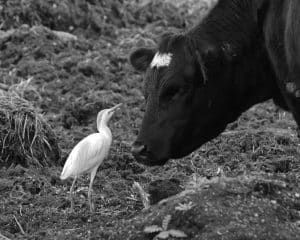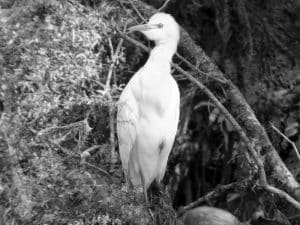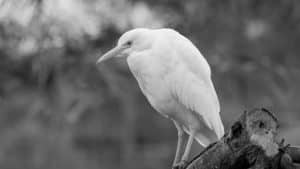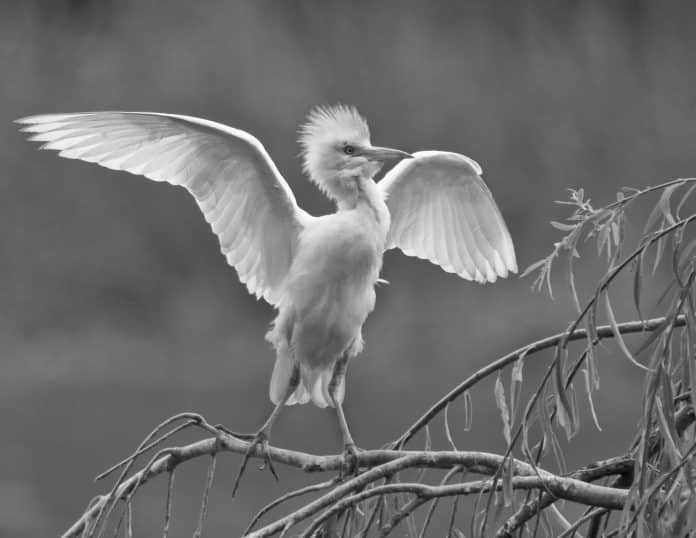Introduction to the Cattle Egret
The Cattle Egret in Tanzania, scientifically known as Bubulcus ibis, is a small heron species belonging to the Ardeidae family. These birds are easily recognizable by their white plumage, short yellow beaks, and yellow legs. During the breeding season, they develop stunning orange-buff plumes on their head, neck, and back, adding to their allure. Cattle Egrets are often found in close proximity to cattle, hence their name, as they forage for insects stirred up by the movement of grazing livestock.
Habitat of the Cattle Egret in Tanzania

In Tanzania, the Cattle Egret is widely distributed across various habitats, ranging from grasslands and savannas to wetlands and agricultural areas. They are commonly spotted in both rural and urban settings, often seen perched on the backs of cattle or foraging in freshly plowed fields. These adaptable birds have thrived in human-altered landscapes and can be found near rivers, lakes, and marshes, where they seek out insects and small vertebrates for sustenance.
The presence of water sources is crucial for the Cattle Egret, as they rely on wetlands for feeding and roosting. During the breeding season, they congregate in colonies near water bodies, constructing nests in trees or shrubs close to their foraging grounds. The abundance of suitable habitats in Tanzania has provided these birds with ample opportunities to thrive and proliferate across the country.
Behavior and Feeding Habits
Cattle Egrets are highly sociable birds, often seen in large flocks as they search for food. Their foraging behavior is particularly fascinating, as they have developed a symbiotic relationship with grazing animals. These birds trail behind cattle, zebras, and other large mammals, capitalizing on the insects and small creatures flushed out by the animals’ movement. This behavior not only benefits the egrets by providing easy access to prey but also aids the livestock by reducing the population of pests in the vicinity.
When not engaged in foraging, Cattle Egrets can be observed engaging in elaborate courtship displays during the breeding season. Males perform captivating aerial maneuvers and vocalizations to attract potential mates, creating a spectacle of grace and agility. This behavior, coupled with their striking breeding plumage, adds an enchanting dimension to the observation of these birds in their natural environment.
Breeding and Nesting Sites
The breeding biology of Cattle Egrets is a marvel of coordination and communal nesting. In Tanzania, these birds form breeding colonies, often in close proximity to water bodies where food is plentiful. They construct platform nests in trees or bushes, using twigs, grass, and other plant material to create sturdy structures for incubating their eggs. The communal nature of their nesting habits results in densely packed colonies, with each pair fiercely defending its nesting territory from neighboring birds.
During the breeding season, the air is filled with the sights and sounds of Cattle Egrets engaging in courtship rituals, nest building, and territorial displays. The vibrancy of their breeding colonies presents a prime opportunity for birdwatchers and wildlife photographers to witness the intricate dynamics of these avian communities.
Migration Patterns

Cattle Egrets are known for their migratory behavior, undertaking long-distance journeys in response to changing environmental conditions. In Tanzania, these birds exhibit both local movements within the country and broader migration patterns across the continent. As the seasons shift and food availability fluctuates, Cattle Egrets display remarkable adaptability, relocating to areas where sustenance is abundant.
The migration of Cattle Egrets in Tanzania is a remarkable spectacle, as flocks of these birds traverse the skies in coordinated patterns, their white plumage contrasting against the azure backdrop. Observing the ebb and flow of their movements provides a profound appreciation for the interconnectedness of ecosystems and the resilience of migratory species in the face of environmental changes.
Conservation Efforts and Threats
While Cattle Egrets are considered to be of least concern in terms of conservation status, they are still vulnerable to various threats, including habitat loss, pollution, and disturbance at breeding sites. In Tanzania, conservation efforts aimed at preserving wetlands and natural habitats play a crucial role in safeguarding the long-term viability of Cattle Egret populations.
By raising awareness about the importance of wetland conservation and sustainable land use practices, conservation organizations and local communities contribute to the protection of the Cattle Egret and other avian species. Through collaborative initiatives, such as habitat restoration, environmental education, and research, these efforts help mitigate the potential impacts of human activities on the habitats and well-being of these majestic birds.
Spectacular Sightings of Cattle Egrets in Tanzania
Tanzania offers unparalleled opportunities for witnessing the captivating presence of Cattle Egrets in their natural environment. From the vast plains of the Serengeti to the lush wetlands of the Selous Game Reserve, these birds can be observed in a myriad of settings, each offering a unique perspective on their behavior and interactions with the surrounding landscape.
One of the most remarkable spectacles is the sight of Cattle Egrets in the midst of the Great Migration, as they accompany herds of wildebeest and other ungulates, taking advantage of the insects stirred up by the movement of the animals. The juxtaposition of these elegant birds against the backdrop of the migrating herds creates a visual symphony of wildlife that is unparalleled in its grandeur and drama.
Best Times and Locations for Birdwatching
For avid birdwatchers seeking to observe Cattle Egrets in Tanzania, certain times and locations offer optimal conditions for sightings. The dry season, spanning from June to October, is an ideal period for birdwatching, as the reduced vegetation and concentrated water sources make it easier to spot these birds in their natural habitats. Additionally, wetlands such as Lake Manyara and the Rufiji River in the Selous Game Reserve are renowned for their abundance of avian life, providing excellent opportunities for birdwatching enthusiasts.
The early morning and late afternoon present prime viewing times, as the soft light and cooler temperatures create favorable conditions for observing and photographing Cattle Egrets. Patience and attentiveness are key virtues for birdwatchers, as the subtle movements and behaviors of these birds unveil a world of intrigue and elegance that rewards dedicated observation.
Photography Tips for Capturing Cattle Egrets

Capturing the grace and beauty of Cattle Egrets through photography requires an understanding of their behavior and natural habitat. When photographing these birds in Tanzania, it is essential to respect their space and minimize any disturbances that may disrupt their activities. Utilizing long lenses and setting up inconspicuously at vantage points near their foraging sites and breeding colonies can yield striking images without causing undue stress to the subjects.
Framing the Cattle Egret within the context of its surroundings, whether against the backdrop of a sweeping savanna or the shimmering surface of a wetland, enhances the visual narrative of the photograph. Paying attention to the interplay of light and shadow, the fluidity of their movements, and the vibrancy of their plumage allows photographers to capture the essence of these birds in their natural element.
Conclusion
The Cattle Egret embodies the harmonious coexistence of wildlife and human activities, thriving in landscapes shaped by agricultural practices and natural processes. In Tanzania, these birds serve as a testament to the resilience and adaptability of avian species, captivating the imagination of all who are fortunate enough to witness their presence. By understanding their habitat, behavior, and the factors that contribute to their conservation, we can appreciate the intricate tapestry of life that encompasses these magnificent birds and the environments they inhabit.


































